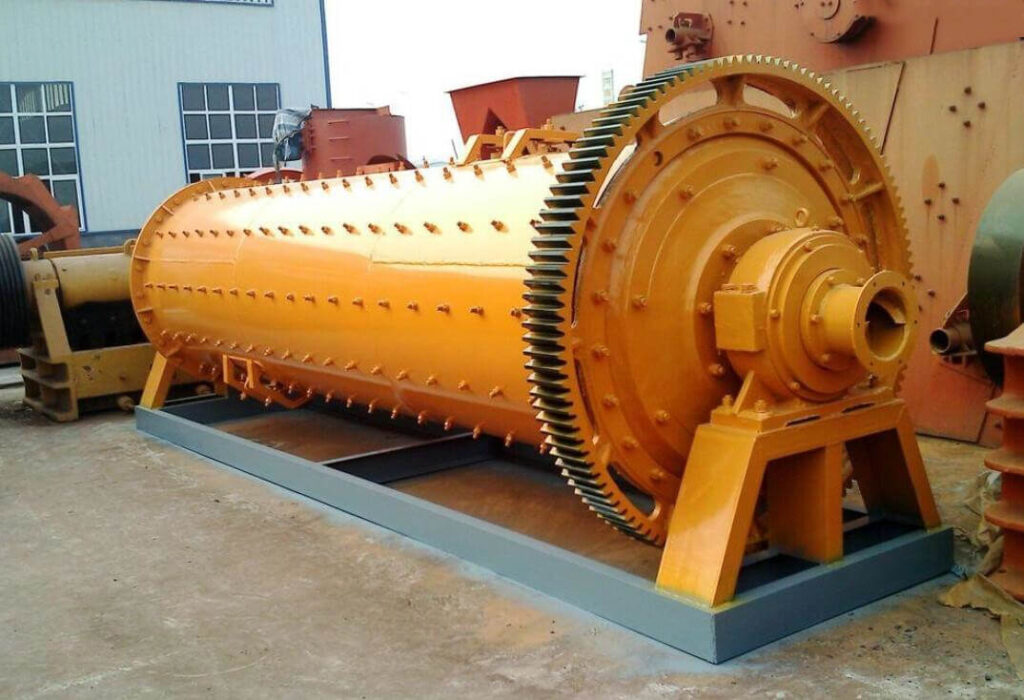Ball mill is a common crushing equipment widely used in mining, metallurgy, chemical industry, and other fields. An overflow ball mill is a basic form of ball mill, its main feature is that the feeding port and the discharging port are set at both ends of the grinding cylinder. The material enters the grinding cylinder through the feeding port and is subjected to friction and impact force in the cylinder After that, it is discharged through the discharge port.
Overflow Ball Mill
Overflow ball mill equipment can be divided into dry overflow ball mill and wet overflow ball mill according to the conveying form of the material to be ground. In recent years, with the continuous development of grinding technology, wet grinding has become the mainstream process, and overflow ball mill equipment is widely used as the main equipment in wet grinding.
The overflow ball mill is mainly used for the wet grinding various ores. In the grinding process, while continuously feeding materials to the mill, a certain amount of water is also continuously fed, so that the finely ground materials and water form a mixed fluid. The ore pulp is discharged from the mill in a self-flowing manner to complete the grinding operation.
Overflow Ball Mill Type
- Overflow ball mill equipment– short tube ball mill
The cylinder length L is less than twice the cylinder diameter D. The ball mill with L≤2D is a short cylinder ball mill, mostly with a single chamber structure, mainly used for rough grinding or primary grinding in mineral processing plants. Its operating efficiency is high, 2-3 ball mills can be used in series simultaneously, and its application range is wide. - Overflow ball mill equipment – medium and long barrel ball mill
When the cylinder length is L=3D, it is a medium and long ball mill. Generally, 1 or 2 bins can be used for coarse or fine-grain operations. - Overflow ball mill equipment – long cylinder ball mill
When the cylinder length is L≥4D, it is a long ball mill, generally divided into 2-4 bins and mainly used for fine-grained material grinding.

Working Principle
Rolling bearings support the barrel of the overflow ball mill, which rotates slowly through the transmission mechanism. The material is fed from the feeding end of the barrel, and the material is crushed in the barrel due to the impact and self-grinding of steel balls and ore itself. Due to the continuous feeding of materials, the pressure promotes the material in the barrel to move from the feeding end to the discharging end. The ore slurry is higher than the lower edge of the hollow shaft at the ore discharging end and overflows by itself. The hollow shaft has anti-helical blades, which can return the overflowing steel balls and coarse ore blocks to the mill.
The main bearing is a key part of the overflow ball mill equipment, and full attention must be paid to its lubrication. Generally, thin oil is used for centralized circulation lubrication. The oil flows through the pump and is pressed into the main bearing and transmission bearing in four ways, then discharged to the drain at the bottom of the bearing oil pipe, and then back to the tank. For medium and small ball mills, there are methods such as automatic oil ring lubrication, oil cup drip lubrication, or solid lubricant. Some concentrators are equipped with an automatic oil cut-off alarm device to ensure the reliability of lubrication.
The overflow-type ball mill is supported on the main bearing through the hollow shafts at both ends. Among the two hollow shafts, one of the two hollow shafts can be axially expanded and contracted on the main bearing, and the other is fixed. Since the gear transmission of the ball mill will generate an axial force, a hollow journal is designed with two shoulders, and the distance between the shoulders is exactly equal to the length of the bearing bush, thereby preventing axial movement. The other hollow journal has no shoulder, and its length is 5-25mm longer than the bearing bush. When the cylinder is heated and stretched or deflected due to load, it can freely expand and contract within a certain range. Generally, the journal close to the transmission ring gear is selected as a fixed hollow journal. The hollow journal is equipped with a tapered bush and a bearing bush, and the cooperation between the hollow journal and the inner sleeve must be tight and sealed. To make the slurry surface in the ball mill have a certain inclination, the inner diameter of the hollow journal at the discharge end is slightly larger than the inner diameter of the hollow journal at the feed end. The inner surface of the hollow journal can be smooth or with spiral blades. The forward spiral blades in the hollow journal at the feed end are used to transport materials; the reverse spiral blades in the hollow journal at the discharge end can make coarse particles Material returns and prevents balls from running out. The transmission gear ring is fixed on the barrel at the ore discharge end, and meshes with the pinion, and the motor drives the barrel through the pinion gear and the gear ring.
The overflow ball mill can grind iron ore, copper ore, ferrous metal, and non-ferrous metal, and is very popular in metallurgy, building materials, construction, the chemical industry, and other fields. It belongs to high-end equipment. It is generally used as the core equipment in the mineral processing production line. Its main function is grinding. Its main advantages are high grinding precision and large production capacity. Only such equipment can be better used by users and valued by users. The economic benefits created are also quite amazing. JXSC is a professional manufacturer of ball mills. Its wet overflow ball mills have good wear resistance, long service life, and easy maintenance.
